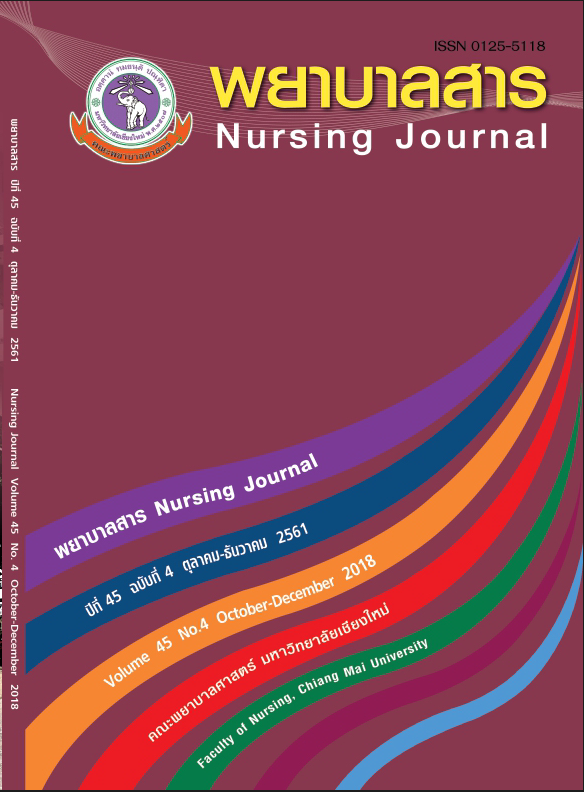Parental behavior enhancement toward childhood home accidental injury prevention
Keywords:
Parental behavior enhancement, Childhood home accidental injury preventionAbstract
Home accidental injury has been one of the leading causes of death in children under the age of five, particularly it often happened under guardians’ supervision. Parental behaviour change is needed to reduce the risk of home injury in young children. The key factors influencing parental behaviour on child home accidental injury prevention include cognition, awareness, anxiety, and intention of parents. The role of child healthcare provider and nurse is to enhance greater understanding of parental behaviour development in regard to childhood home accidental injury prevention through Gibson’s empowerment concept. This can be a valuable benefit for nursing implications and healthcare providers to shape child health policy and develop child health promotion plan.
References
Bandura, A. (1997). Self-efficacy: The exercise of control. New York: Freeman.
Centers for Disease Control and Prevention. (2012). Vital Signs: Unintentional injury deaths among persons aged 0-19 years–United States, 2000-2009. Morbidity and Mortality Weekly Report, 61(15), 270-276.
Child Safety Promotion and Injury Prevention Research Centre. (2014). Safe products for children. Retrieved 5 November 2016, from Child Safety Promotion and Injury Prevention Research Centre http://www.csip.org/
Conner, M. & Sparks, P. (2005). Theory of planned behaviour and health behaviour
In M. N. Conner, P. (Ed.), Predicting health behaviour (pp. 170-222). London: Bell & Bain.
Gibson, C.H. (1993). Empowerment theory and practice with adolescents of colour in the child welfare system. Families in Society, 74(7), 387-396.
Irving, L. (2011). Preventing unintentional injuries in children and young people under 15. Community Practitioner 84(3), 36-38.
Jonkheijm, A., Zuidgeest, J.J., Dijk, M., & Van, AS. AB. (2013). Childhood unintentional injuries: supervision and first aid provided. African Journal of Paediatric Surgery, 10(4), 339-344.
Kendrick, D., Young, B., Mason-Jones, A.J., Ilyas, N., Achana, F.A., Cooper, N.J., Hubbard, S.J., Sutton, A.J., Smith, S., Wynn, P., Mulvaney, C., Watson, M.C., & Coupland, C. (2013). Home safety education and provision of safety equipment for injury prevention (review). Evidence Based Child Health, 8(3), 761-939.
Long, T. (2007). What are the ethical issues in research? In C. Webb, Johnson, M., &Long, T (Ed.), Research ethics in the real world: Issues and solutions for health and social care (pp. 47-62). China: ELSEVIER.
Morrongiello, B.A. & McArthur, B.A. (2010). Parent supervision to prevent injuries. Retrieved 28 April 2017, from Centre of Excellent for Early Childhood Development
http://www.child-encyclopedia.com/sites/default/files/textes-experts/en/654/parent-supervision-to-prevent-injuries.pdf
Munro, S.A., Niekerk, A.V. & Seedat, M. (2006). Childhood unintentional injuries: The perceived impact of the environment, lack of supervision and child characteristics. Child: Care, Health & Development, 32(3), 269-279.
Nansel, T.R., Weaver, N.L., Jacobsen, H.A., Glasheen, C. & Kreuter, M.W. (2008). Preventing unintentional pediatric injuries: A tailored intervention for parents and providers. Health Education Research, 23(4), 656-669.
National Statistical Office, Thailand. (2014). Family statistics. Retrieved 28 April 2017, from service.nso.go.th/nso/nsopublish/citizen/news/news_family.jsp
Ngamsuoy, A. (2014). Developing a parental behaviour programme for child home injury prevention in Thailand: Parents’ experiences and perceptions. Doctoral Dissertation. Newcastle upon Tyne: Northumbria University Library.
Payne, B.K. (2012). Control, awareness, and other things we might learn to live without In S. T. M. Fiske, C.N (Ed.), The sage handbook of social cognition (pp. 12-30). London: SAGE.
Pearson, M., Garside, R., Moxham, T. & Anderson, R. (2011). Preventing unintentional injuries to children in the home: A systematic review of the effectiveness of programmes supplying and/or installing home safety equipment. Health Promotion International, 26(3), 376-392.
Peden, M., Oyegbite, K., Ozanne-Smith, J., Hyder, A.A., Branche, C., Rahman, A.F., & et al. (2008). World report on child injury prevention: Geneva: WHO & UNICEF.
Phelan, K.J., Khoury, J., Xu, Y., Liddy, S., Hornung, R., & Lanphear, B.P. (2011). A randomized controlled trial of home injury hazard reduction. Formerly Archives of Paediatric & Adolescent Medicine, 165(4), 339-345.
Rachman, S. (2013). Anxiety (3rd ed.). New York: Psychology Press.
Reeve, J. (2009). Understanding motivation and emotion (5th ed.). New Jersey: John Wiley & Son, Inc.
Stringer, E.T. (2014). Action research (4th ed.). London: Sage.
Unicef, World Health Organization, World bank group, & United nations. (2017). Levels & trends in child mortality Retrieved 28 September 2018, from https://www.unicef.org/publications/files/Child_Mortality_Report_2017.pdf
Van, AS.AB. & Stein, D.J. (2010). Child safety: A neglected priority. World Journal of Pediatrics 6(4), 293-295.
World Health Organization. (2010). Profile of child injuries: selected member states in the Asia-Pacific region. New Delhi: Regional office for South-East Asia.
Downloads
Published
How to Cite
Issue
Section
License
บทความที่ได้รับการตีพิมพ์เป็นลิขสิทธิ์ของวารสารพยาบาลสาร
ข้อความที่ปรากฏในบทความแต่ละเรื่องในวารสารวิชาการเล่มนี้เป็นความคิดเห็นส่วนตัวของผู้เขียนแต่ละท่านไม่เกี่ยวข้องกับมหาวิทยาลัยเชียงใหม่ และคณาจารย์ท่านอื่นๆในมหาวิทยาลัยฯ แต่อย่างใด ความรับผิดชอบองค์ประกอบทั้งหมดของบทความแต่ละเรื่องเป็นของผู้เขียนแต่ละท่าน หากมีความผิดพลาดใด ๆ ผู้เขียนแต่ละท่านจะรับผิดชอบบทความของตนเองแต่ผู้เดียว






